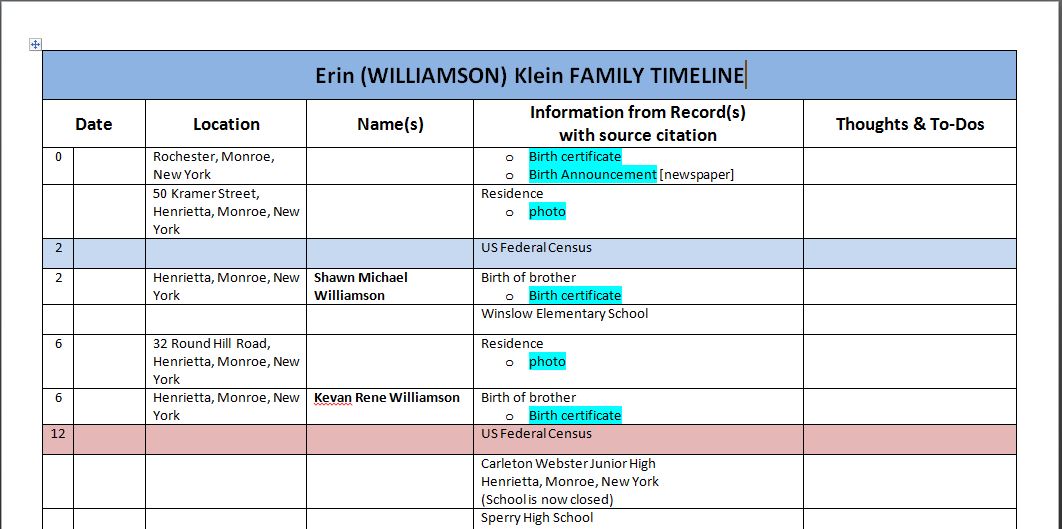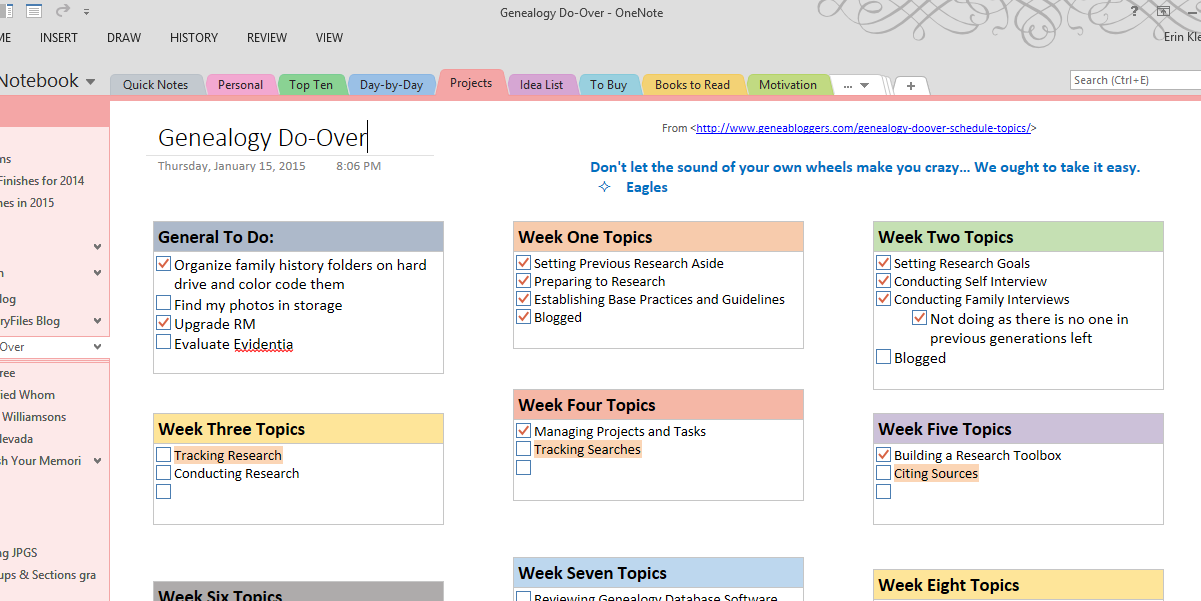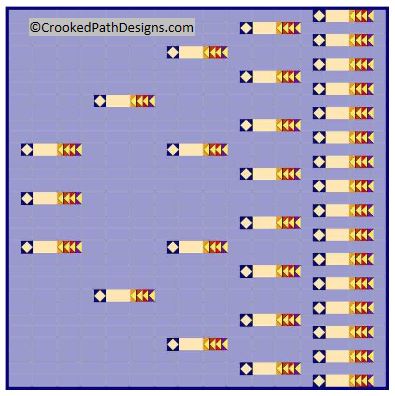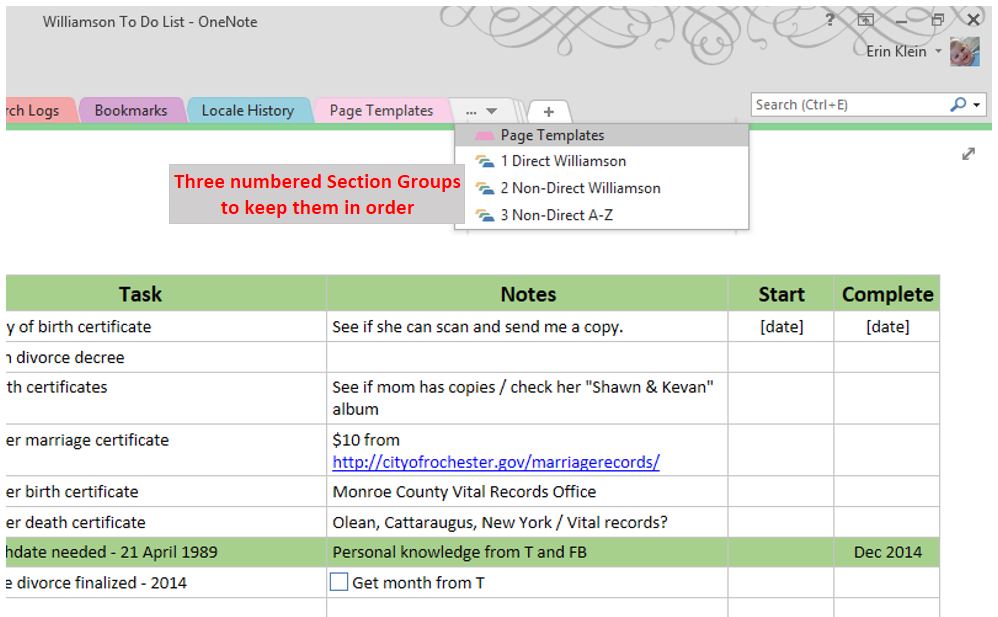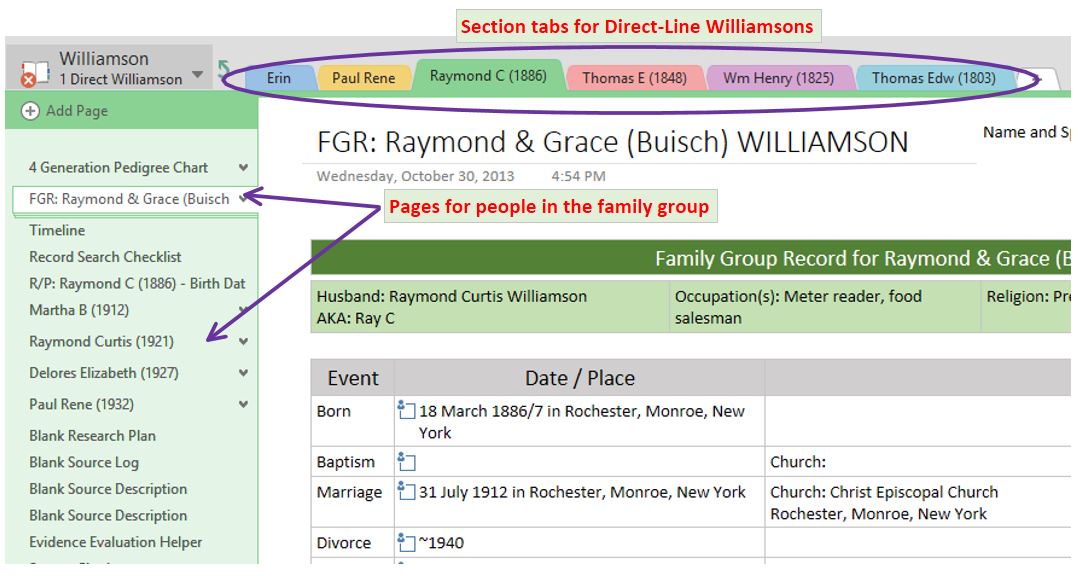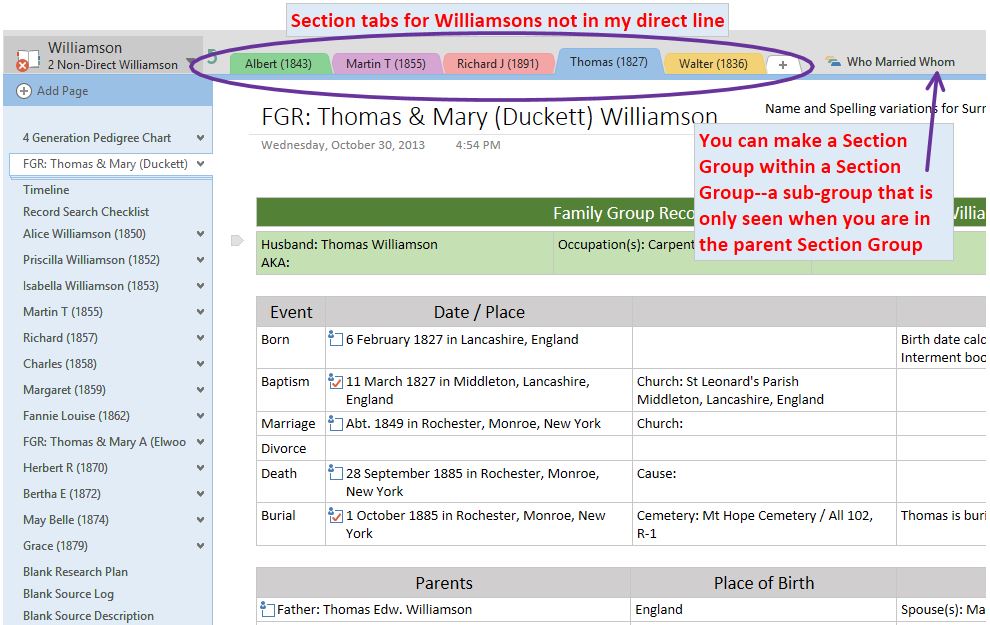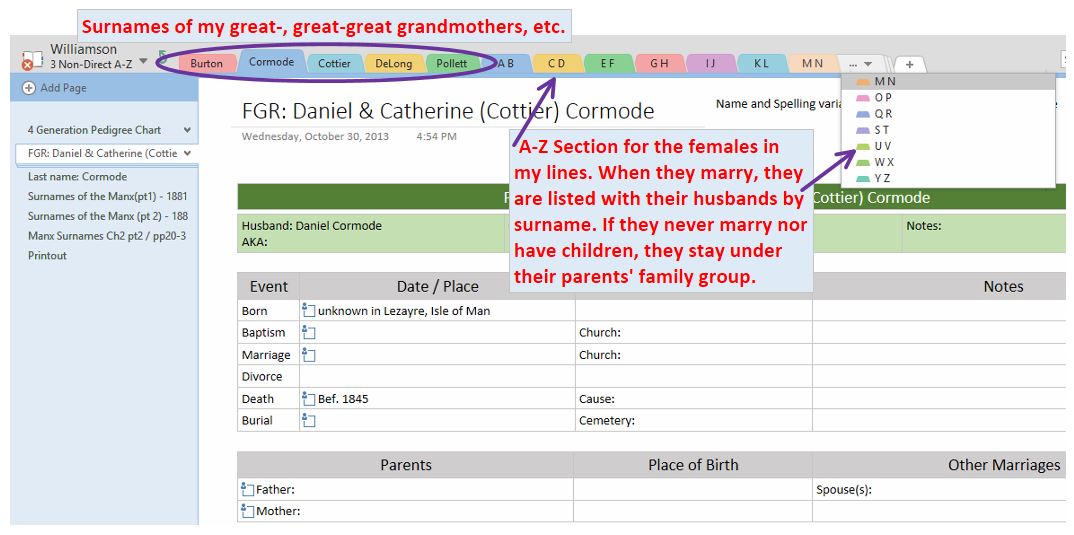Updated 6 February 2015: It appears my source of information about the Ancestry free access day was misinformed. The free access appears to be for records in the UK, not access to all Ancestry records. I edited the post to reflect this change.
This weekend Ancestry is offering free access to their UK records. I know quite a few of you are involved in the Genealogy Do-Over and the free access is a Bright Shiny Object (#BSO) that could suck away your weekend in no time. For me it is a BSO because I have given up my Ancestry membership temporarily while I work on getting my files in order and I will not be resisting the temptation of free access. I plan to take advantage of it. Fortunately I won’t have unlimited Internet access until Sunday afternoon so I cannot get sucked into a weekend-long, follow-every-rabbit-trail, download-until-I-am-cross-eyed marathon. I have taken advantage of the free access to UK and Canadian records in the past and used OneNote to aid me in the process.
This is a post about how I use OneNote when the free access to Ancestry’s records is offered without letting it becoming a Really Big and Beautiful BSO that sucks me in not only for the weekend but possibly even longer. I could enter the record images I am downloading onto a Research Log. However it takes time and thought to be sure I am putting information in the log correctly and on the correct log. (I have a separate one for each surname.) I also have a tendency to get sidetracked looking at people’s trees and using the search function to fall down rabbit holes. I want to keep as focused as I can and I want a quick and easy way to download the records and cite the sources. I will go back at a later date and analyze the records, record everything in my Research Plan and on my Research Log and then write up my written conclusion before I enter anything into my genealogy software—steps 8 through 13 of my workflow.
If you want to use my method for quickly capturing records, there are a couple of things you need to do before you start.
- Make a new folder on your hard drive just for the record images you are going to be downloading during the free access.
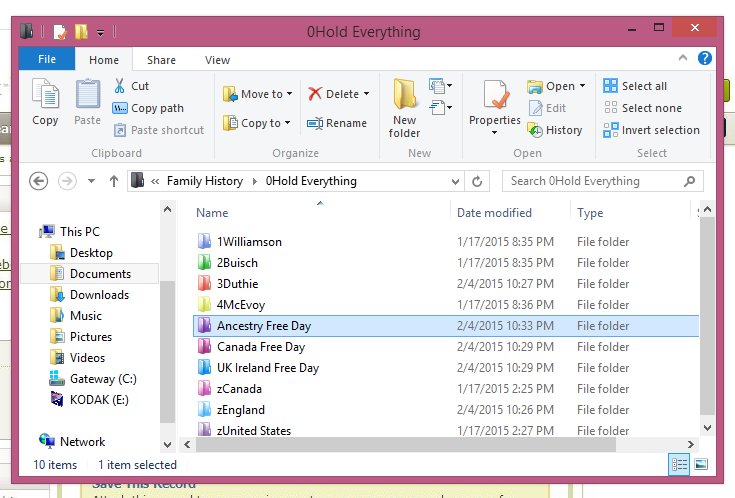
Because I am participating in the Genealogy Do-Over, all my files are in a HOLD folder. I created a new folder called Ancestry Free Day for this weekend’s downloads. You can see that I also have a folder for a Canada Free Day and a UK Ireland Free Day that were previously held.
- Be sure to install the Clip to OneNote app for your web browser. Here is the link for the OneNote Clipper: https://www.onenote.com/Clipper/OneNote
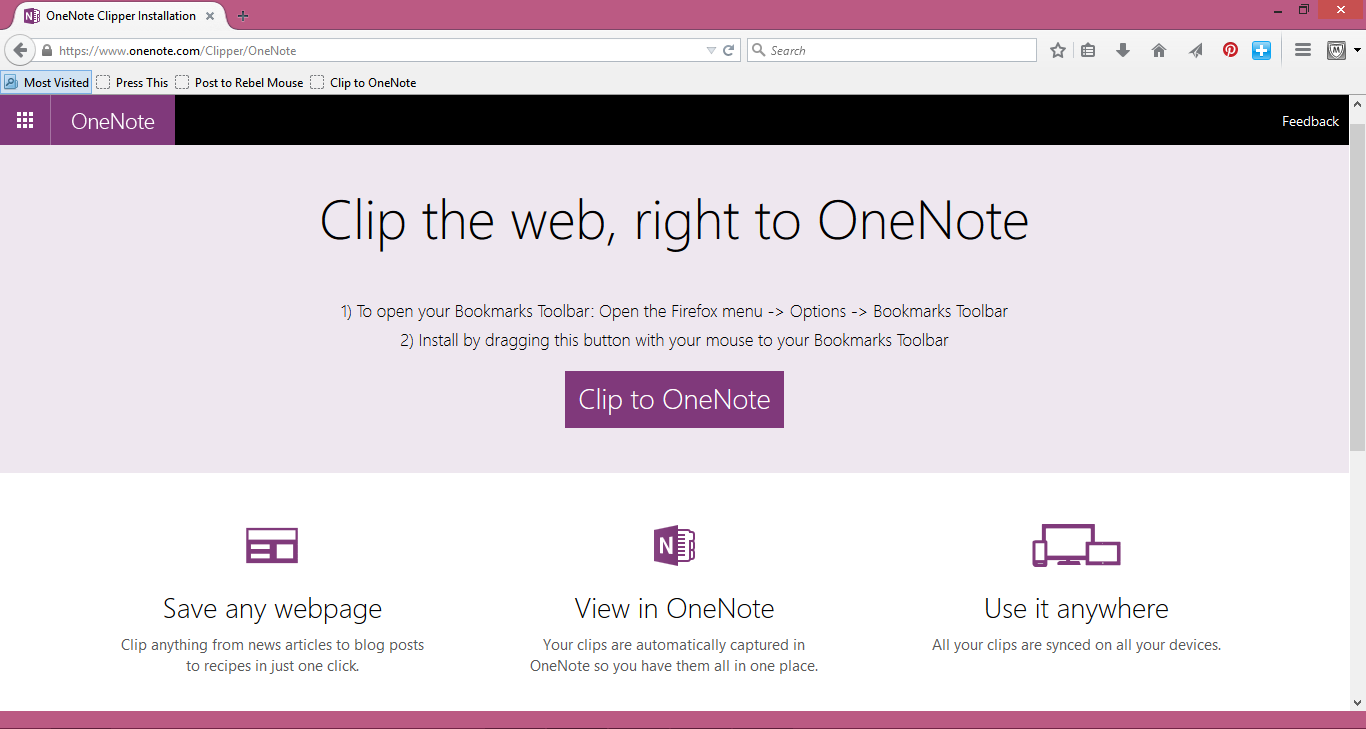
I use FireFox as my web browser so the OneNote Clipper app web page gives me the instructions on how to install the clipper for FireFox. The page should display whatever instructions you need to install the clipper in your web browser.
Now once the free access begins, you are going to start downloading record images to the folder you created. Some of the images you are going to know that, yes, this is my person and some you are not going to be sure. Download them anyway. Trust me. Just do it. If I find five Ray Williamsons in the the 1930 Rochester Census, I am going to download all the images. If I find three baptism records for William Williamson in Lancashire England, I am going to download all of them. You are going to download now and analyze their usefulness later. I figure if a record turns out to be useless or a duplicate, I can delete it later. It does help your focus if you have some research goals already in mind though! My focus for this free access weekend is going to be on my direct lines from England and the Isle of Man.
As you are downloading and naming the saved records, number them in chronological order. This will help you later with the Source Citations you are going to copy as well.
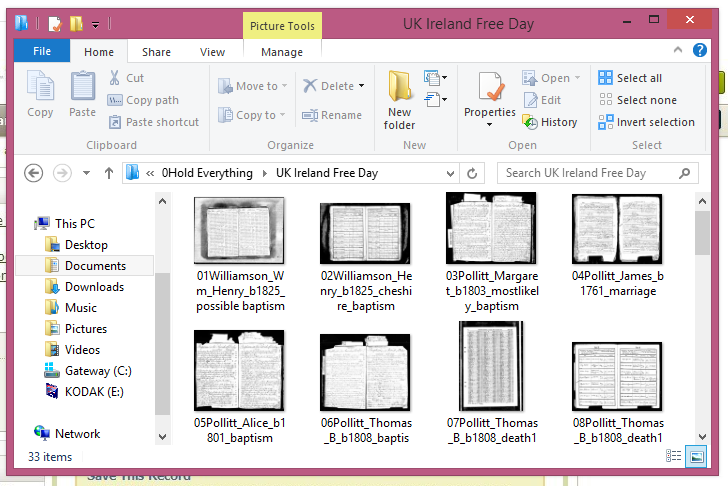
I number them 01, 02, 03, etc. with Surname_FirstName_Initial_b####_recordtype. The b#### is for a birth year—even if it is approximate—as it helps me distinguish between family members with the same name. Along with the record type, I may make personal observations like ‘most likely’ or a place name or something else pertinent to the record image.
I am going to digress here a bit to explain why it is helpful to download records that come up in searches or shaky leaf hints other than those that you know for certain are for your specific ancestor. My great-great grandfather, Wm Henry Williamson was born about 1825 in England. The birth year is guesstimated from a ship’s manifest, censuses and cemetery interment records. His parents are Thomas and Margaret Williamson both born about 1803 in England. There are at least three different Thomas and Margaret Williamson couples that have been linked as possible parents in baptism records to my great-great grandfather on Ancestry and FamilySearch. One Thomas is a farmer in Cheshire, another is a weaver in Lancashire and the third is a tollgate keeper also from Lancashire. So which one is the right couple? Or are any of the linked baptism records the right one for my great-great grandfather?
If I am applying the Genealogical Proof Standard to my research, I should have copies of as many baptisms of the children from these couples as I can find to prove or disprove my written conclusion on whether the farmer, the weaver or the tollgate keeper is Wm Henry Williamson’s father and that a particular baptism record is indeed the correct record for him, right? So I am going to download pretty much every baptism record I can find for any child with parents Thomas and Margaret Williamson in Cheshire and Lancashire.
There are three ways to get the source citation information from Ancestry into OneNote. I realize that the source citation information from Ancestry might not always be in the correct format as outlined by Elizabeth Shown Mills in Evidence Explained nor contain all the information you need to properly cite a source in your genealogy software. Three things I try to consistently do as I am copying citations from Ancestry is to (1)Identify the source citation in such a way that it is clear which record image the citation belongs to (the chronological numbering), (2)Provide myself with the date I accessed the record online and (3)Add the page link in case I need to go back to the record later.
The simplest way to capture the source information for a record image you have downloaded is to use the Clip to OneNote app for your web browser. Anything you clip from the web with the app goes to the Quick Notes Section of the first notebook that was created when you installed OneNote. Even if you renamed that section, your clips from the web should end up there. It takes a few seconds for the record to show up in the Quick Notes Section; but as soon as it does, I add the chronological number in front of the title so this source matches my downloaded record image.
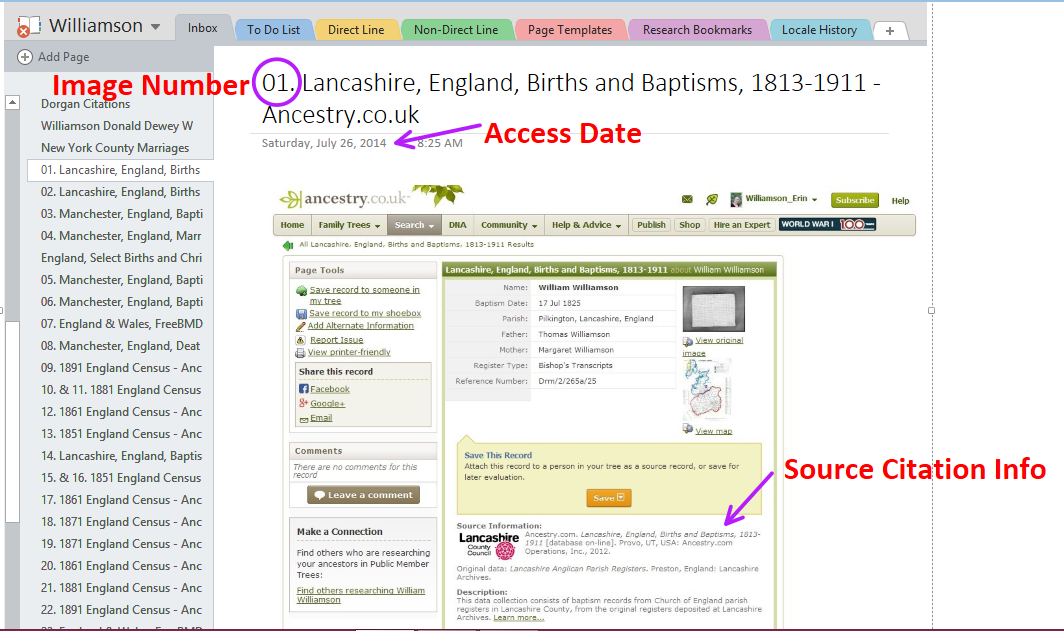
Two things to note—At the bottom of this image is the link to the web page that the image was clipped from. It is inserted automatically on my OneNote page but I didn’t want to make the graphic even smaller to show it. You’ll also note that all my source citation pages that were created during the UK Ireland free access day have been moved from the Quick Notes Section to the Inbox of my Williamson Notebook. That is the drawback to using the Clip to OneNote app—you cannot tell it where to put the clip so you have to go back later and move them.
The second way to capture the source information is to use the Screen Clipping Tool in the Send to OneNote app.
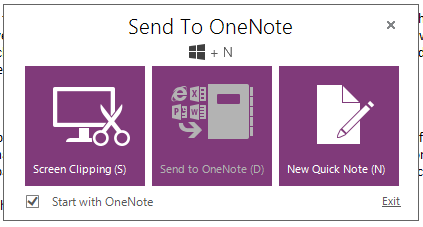
You can clip just the portion of the web page that is relevant to the record image you downloaded. After you have clipped the source citation information, you are asked where you want to send the clip. I send it to the Inbox of the appropriate Surname Notebook.
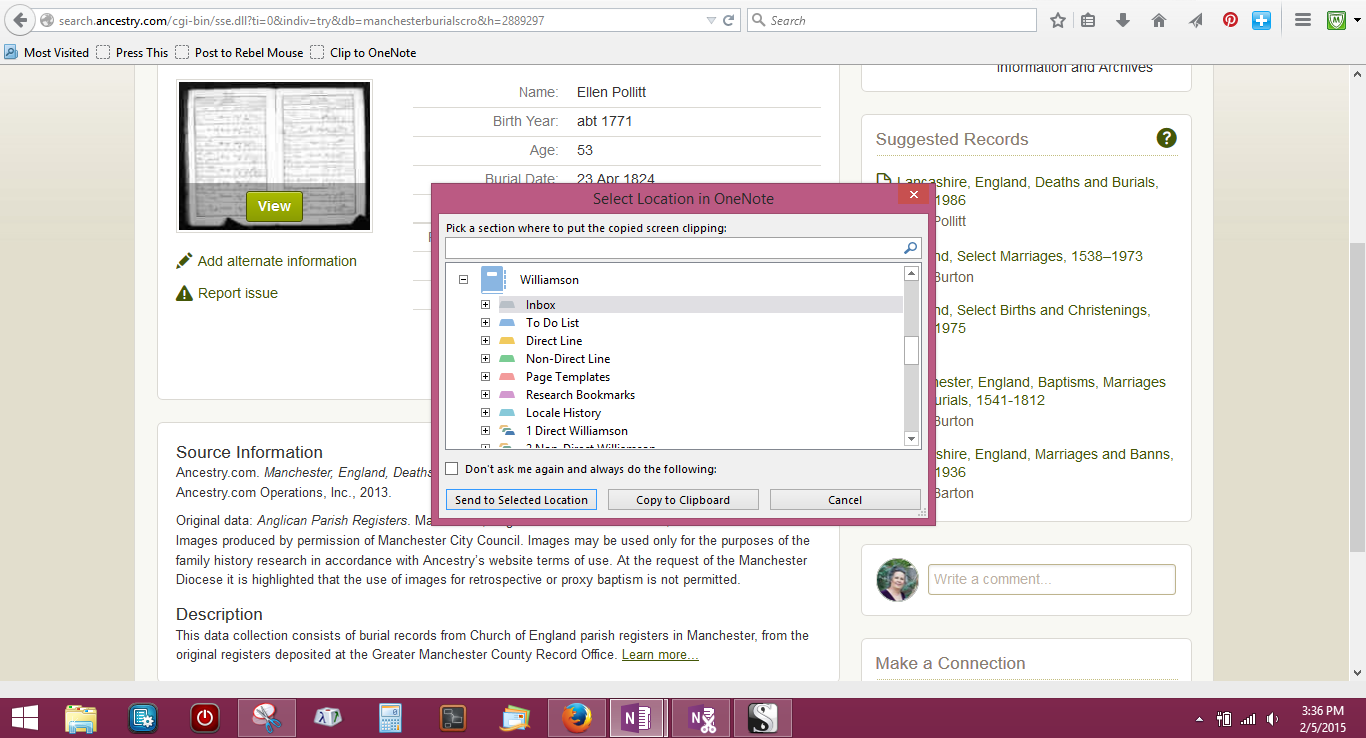
When the clip gets to your Surname Notebook Inbox, you will have to add the title. I use the same number and file name I used when I saved the record image. The drawback to this method is that the web link is not automatically added at the bottom of the page so you have to remember to go back and add it.
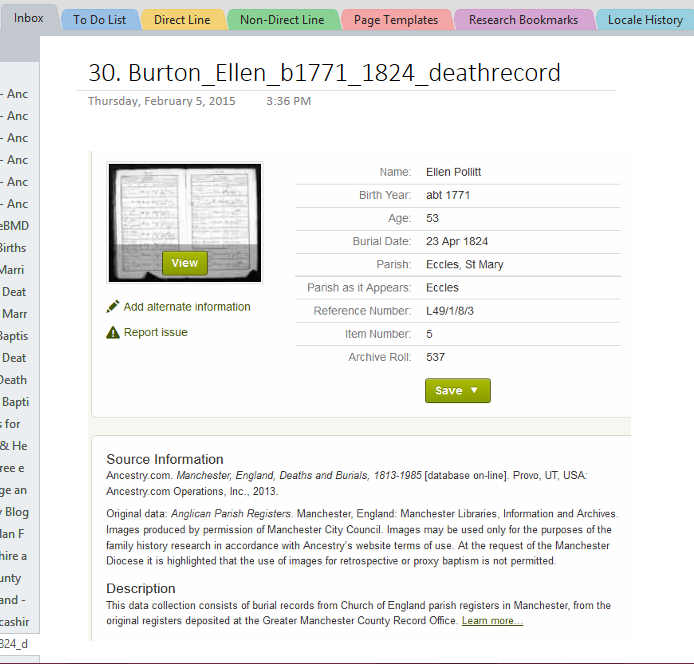
The third method involves a bit more copying and pasting but in the long run it sets you up nicely for inputting information into your Research Log when the time comes to start working with the records and analyzing what you have saved. In your Quick Notes Section or the Inbox of one of your Surname Notebooks, create a new page. Because the folder I created to hold the record images is called Ancestry Free Day, I named the new page Ancestry Free Day Citations.
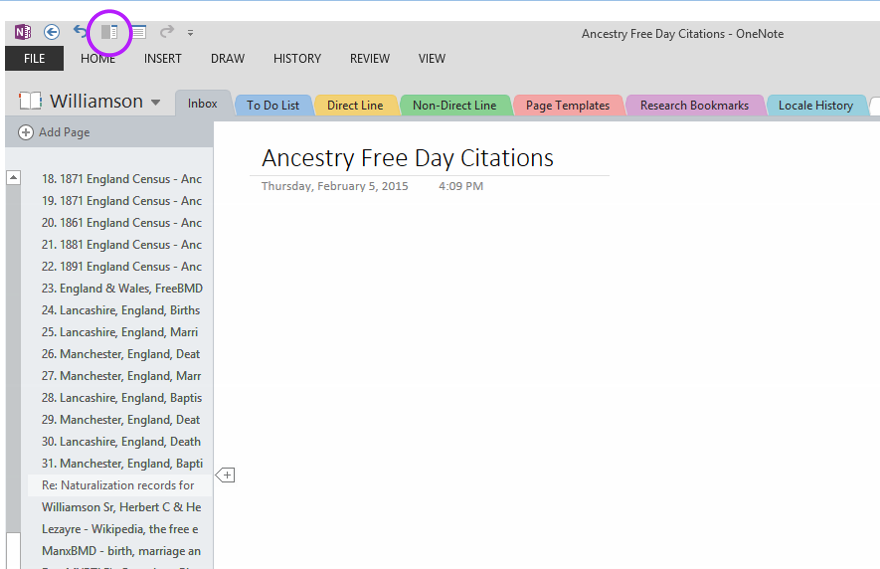
At the top right of OneNote, there is a little icon that looks like a split screen. When you click it, your blank page should shrink and dock itself to the right side of your computer screen. If Quick Notes doesn’t dock to the right of your screen, click on the down arrow under the linked chains and choose Linked Note Options. Under Display, be sure the box next to Dock new Quick Note windows to the side of the desktop is checked. Now you can have your web browser opened and the Quick Notes window at the same time. (You can smoosh the Quick Notes window up a bit if you want to make your browser window just a bit wider.)
The first record I saved is a marriage record for my 4th great grandmother. In Quick Notes, I have copied and pasted the name I used for the downloaded record image, the information about the record image from Ancestry and I have copied but not yet pasted the source citation information. A link back to this web page will also be inserted into Quick Notes. After I am done with that record, I will move on to the Suggested Records links that Ancestry shows me on the current record page (if there are any) and repeat the process.
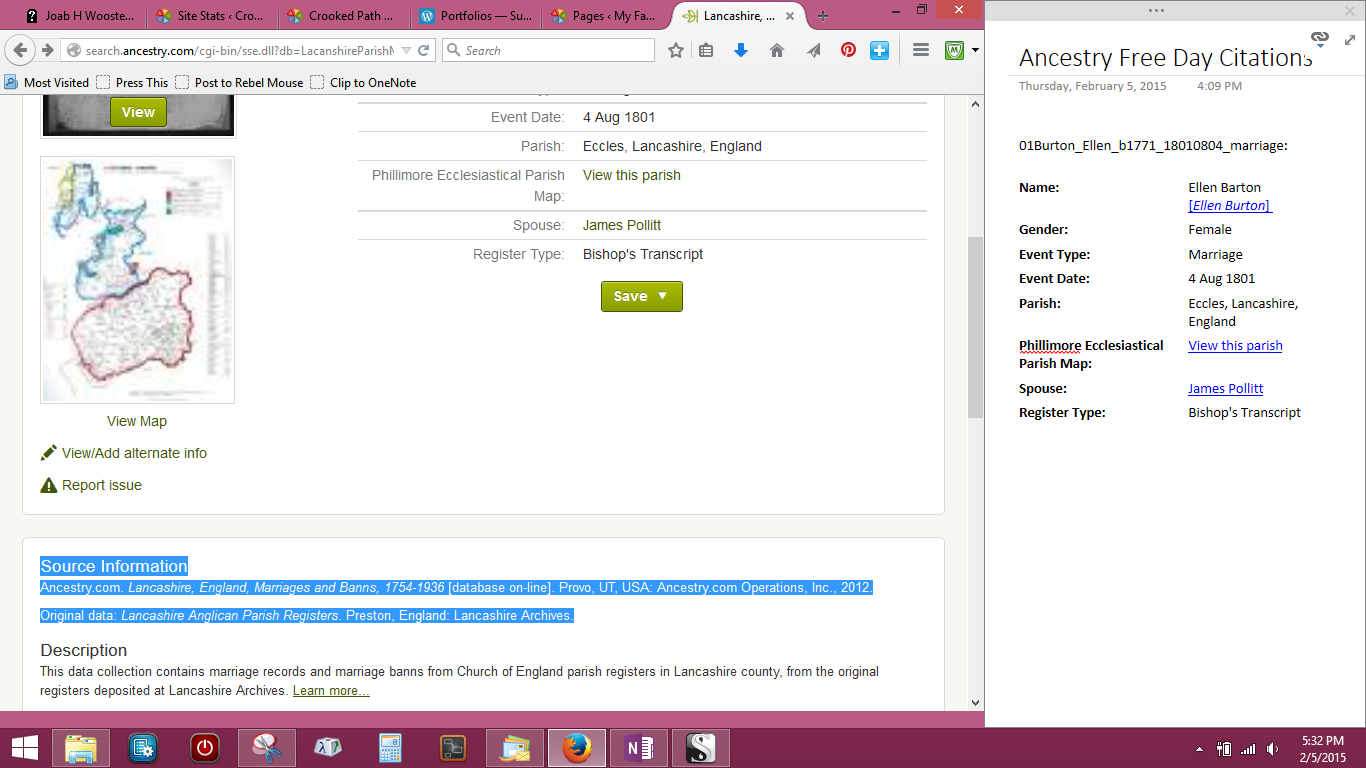
To undock the Quick Notes window, click on the arrow icon. My Ancestry Free Day Citations page will look something like this after I have added all my record image citations. You can see how copying the source citation information this way will lend itself to easy copying and pasting directly into a Research Plan or Record Log at a later date.
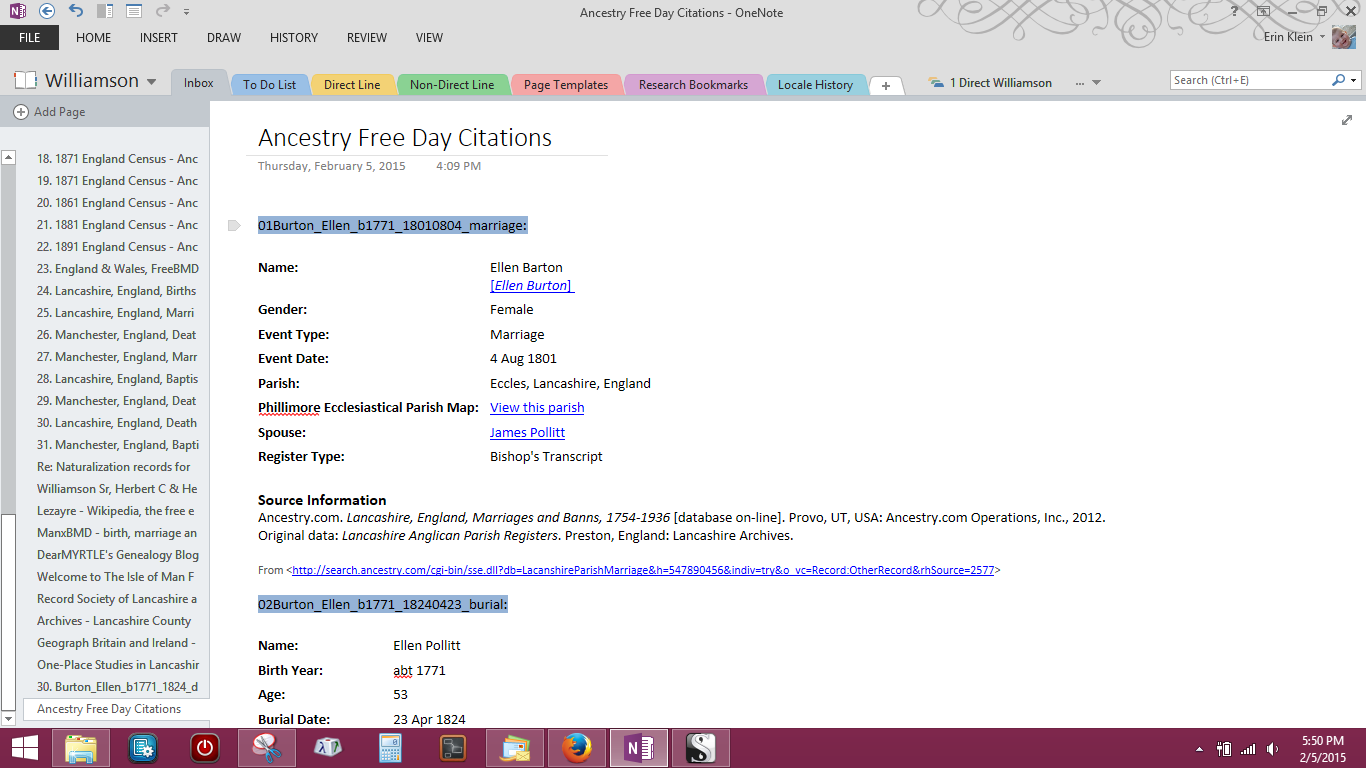
So there you have it. Go, play and download lots of record images to save for a rainy day.
===
Post edited 23 April 2020 to update links to the Genealogy Do-Over.
Cite This Page:
Erin Williamson Klein, “Downloading record images to save for a rainy day.” My Family History Files, 5 February 2015 (https://myfamilyhistoryfiles.com/organization/downloading-record-images-to-save-for-a-rainy-day : [access date]).
Please do not copy without attribution and link back to this page.
Like this:
Like Loading...
